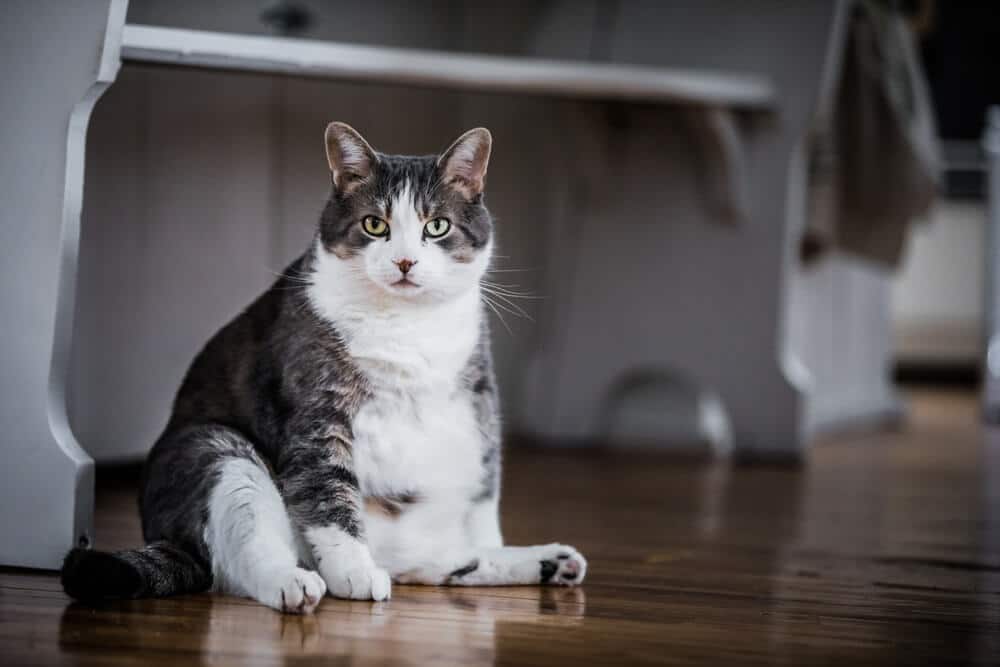
Feline obesity is a big problem (pun certainly intended). It’s so big that 30-45% of cats in the United States are obese, defined as 20% above ideal body weight.
As a nutritional disease, obesity has serious health consequences if left untreated.
This article will teach you about feline obesity and what you can do to treat it.
Quick Overview: Feline Obesity






What Is Feline Obesity?
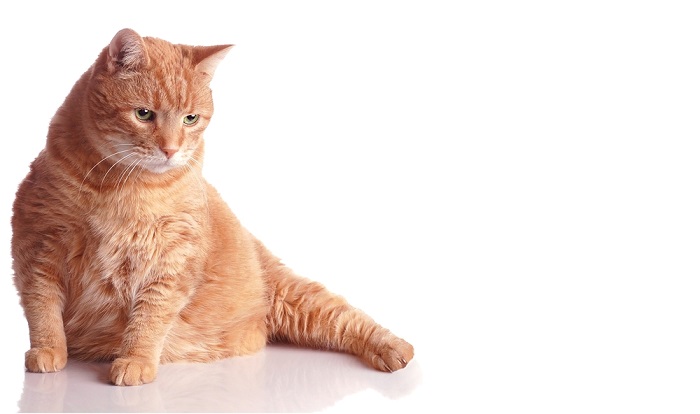
Let’s first go over the basics of feline obesity:
- The science of obesity
- Obesity causes
- Obesity symptoms
- Obesity diagnosis
- Obesity risk factors
- Obesity’s health consequences
Obesity In Cats Explained
The Science
Obesity is characterized by excess fat accumulation. Cats are born with all of the fat cells that they’re going to have. These cells get bigger or smaller but don’t disappear.
With obesity, these fat cells get bigger. It was once thought that fat was inactive. Now we know that fat is biologically active and can wreak havoc on the body of an obese cat. Fat can release inflammatory hormones that put the body in a state of chronic inflammation, which can lead to numerous health problems.
Causes

In most cases of feline obesity, a cat’s calorie intake far exceeds the calories that are burned off. Cats eat what we feed them, so cat parents play a major role in feline obesity.
There are also medical causes of feline obesity, including hypothyroidism (under-active thyroid gland), hyperadrenocorticism (over-active adrenal gland), and insulinoma (insulin-secreting tumor).
Risk Factors
The factors listed below increase a cat’s risk of becoming obese:
- Female
- Neutered
- Indoor cat
- Early-onset weight gain
Symptoms
What does feline obesity actually look like? If your cat is especially rotund and their belly is dragging across the floor, they fit the profile for obesity. Obese cats are also less physically active than cats at an ideal weight.
Diagnosis
Veterinarians have two ways of diagnosing feline obesity: weight and body condition. If a cat’s weight is 20% above their ideal body weight, the cat is obese.
Body condition is evaluated using a body condition score (BCS) chart. BCS is typically scored from 1-9, with 1 indicating emaciation and 8.5-9 indicating obesity. The areas of the body being evaluated are the ribs, tail, head, and belly.
BCS Chart For Cats

You can estimate your cat’s BCS at home. First, look at your cat from the top down. If your cat’s midsection looks like a wide oval with no visible waist, your cat is likely obese.
Next, run your hands along your cat’s sides. If all you feel is fat and no ribs, your cat is probably obese. Discuss your findings with your veterinarian.
Health Consequences
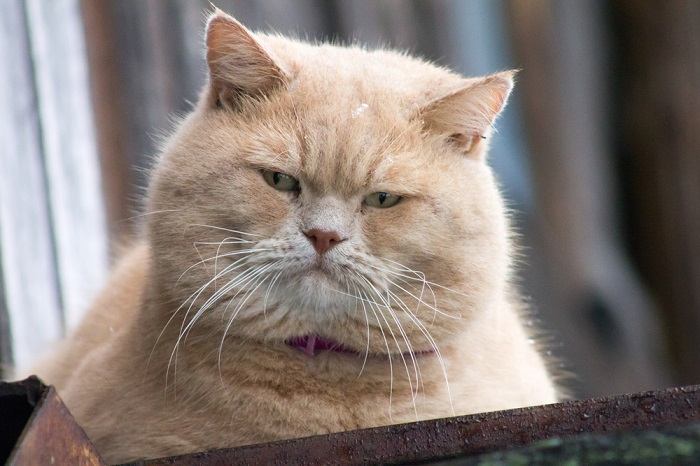
Obese cats face numerous health challenges, listed below:
- Diabetes mellitus
- High blood pressure
- Some types of cancer
- Heart and liver disease
- Decreased immune function
- Decreased breathing capacity
- Potential neurological problems
- Urinary problems (e.g., bladder stones)
- Orthopedic problems (e.g., osteoarthritis)
Feline obesity also decreases lifespan. Obese cats have a mortality rate that is nearly 3 times higher than that of cats at an ideal weight.
Treating Feline Obesity
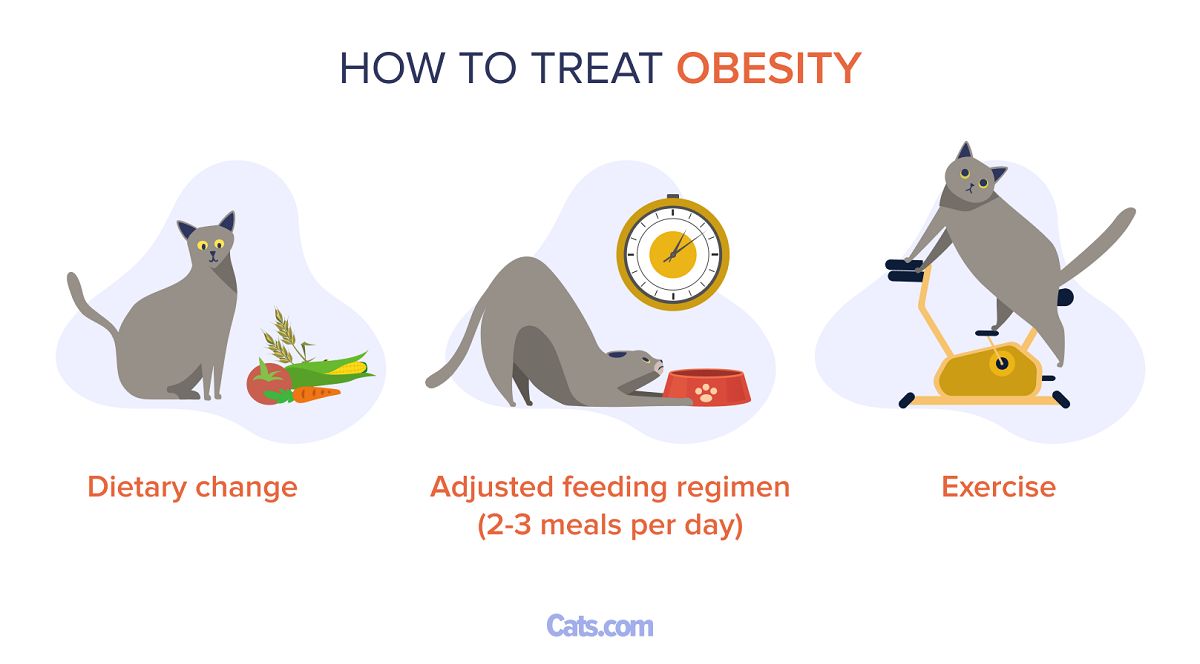
Obese cats need to lose weight to get healthy and have a good quality of life. Specific weight loss benefits include decreased stress on joints, improved heart health, and improved physical fitness.
The weight loss must happen gradually: only 1-2% of body weight per week. You can’t rush the process. Rapid weight loss could lead to a serious liver disease called hepatic lipidosis (fatty liver).
First, schedule an appointment with your veterinarian. Provide a thorough dietary history, including type and amount of food, feeding regimen (free choice or mealtimes), and snacks. Your veterinarian will perform a physical exam and other diagnostic tests to identify or rule out medical causes of your cat’s obesity.
Your veterinarian will then determine your cat’s ideal weight and make some calorie calculations: ‘maintenance calories’ (calories needed to maintain ideal weight) and ‘weight loss calories’ (70% of maintenance calories).
Second, work with your veterinarian to formulate a diet and exercise plan for your cat.
Dietary Changes
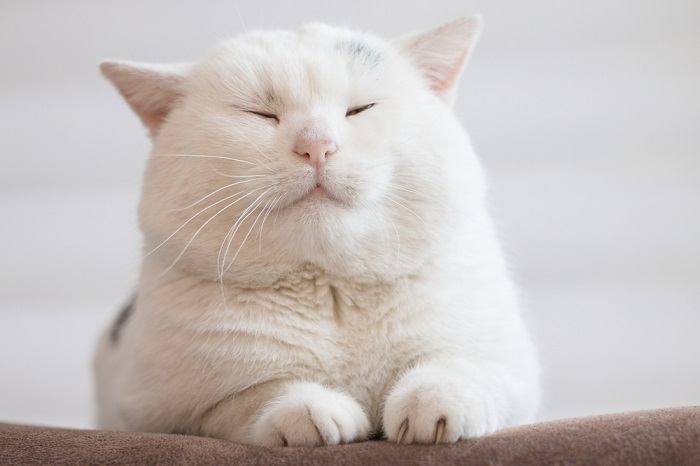
Weight Loss Diet
Simply decreasing the amount of your cat’s current diet can lead to malnutrition. Instead, feed your cat a specially formulated weight loss diet for cats. These diets have fewer calories but are nutrient-dense and meet a cat’s nutritional requirements.
Weight loss diets for cats are low in fat and rich in dietary protein and fiber. Protein helps your cat feel full, while fiber keeps your cat’s digestive system running smoothly. Your veterinarian can recommend an ideal feline weight loss diet and instruct you on how much of it to feed.
Also Read: Best Cat Food for Overweight Cats
Snacks

Snacks aren’t off-limits, but you have to be strict about them. Recommended snacks for cats include morsels of cooked lean meat, a few pieces of kibble, or dried liver. Remember that snacks add calories.
Your veterinarian can calculate how many of your cat’s daily calorie count can come from snacks. Stick to that calorie count.
Feeding Regimen

It’s not just what you feed, it’s how you feed it. Feed your cat 2-3 small meals per day. No free-choice feeding, which contributes to overeating. Also, all feeding, including snacks, should occur in your cat’s bowl.
Place your cat’s bowl out of the kitchen so that your cat isn’t around other food at mealtime. To encourage more physical activity, place the bowl where your cat will need to walk a little further to eat.
If you have multiple cats, feed your obese cat separately to avoid food-sharing.
Your cat will probably beg for more food because they’re eating less. Respond to begging with affection or a short bout of playtime.
Exercise Changes
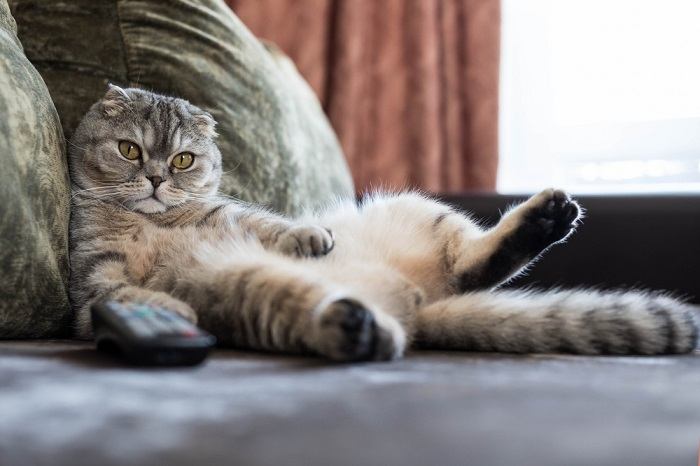
In addition to consuming fewer calories, your cat will need to burn more calories through exercise.
Aim for 15 minutes of exercise, twice daily. Don’t worry if your cat’s not there yet. Start small, with 5-10-minute sessions of playtime. Gradually increase the duration as your cat becomes more physically fit.
Make playtime interactive. Laser and chase are great playtime ideas.
Regular Weigh-ins

Weighing your cat 2-3 times per month will help to ensure that he or she stays on the right track and doesn’t regain the weight.
You’ll need to track your cat’s weight loss. As with people, cats can lose weight, then hit a plateau or even regain weight. Tracking your cat’s weight loss will help you spot problems quickly and make adjustments to the weight loss plan.
Weigh your cat 2-3 times per month. First, weigh yourself on a scale, then weigh yourself while holding your cat. Subtract the second weight from the first weight to get your cat’s weight. For example, if you weigh 130 pounds without your cat and 145 pounds with your cat, then your cat weighs 15 pounds.
Alternatively, you can weigh your cat on a baby scale.
Report your cat’s progress to your veterinarian.
Maintain The Weight Loss
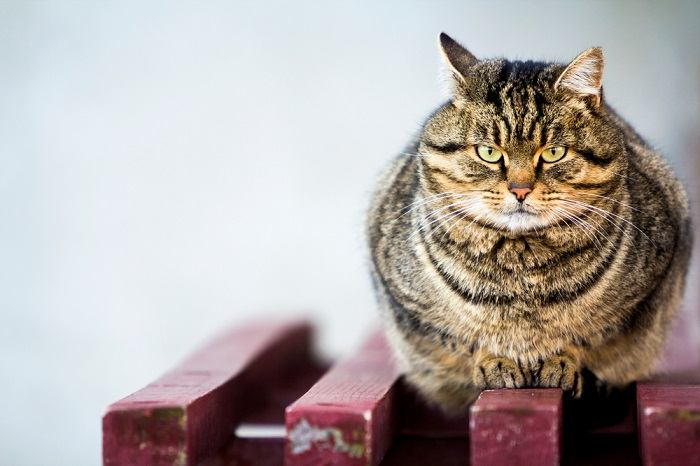
Maintaining weight loss can be just as hard as achieving it. Feed your cat the ‘maintenance calories’ amount and continue with twice-daily exercise. Weigh your cat regularly and alert your veterinarian if the pounds start coming back.
Bringing It Together
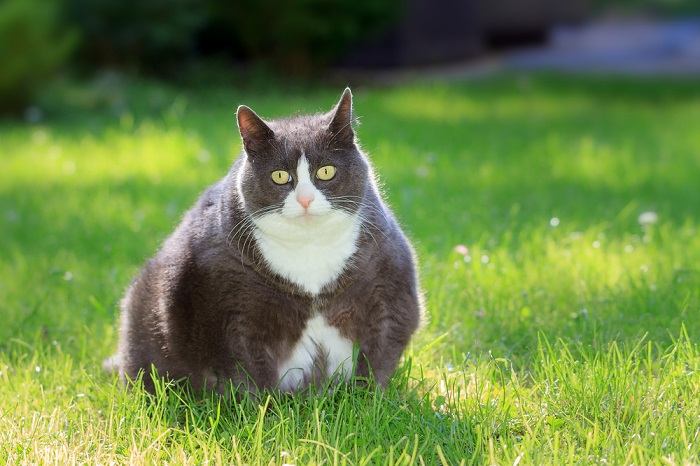
Feline obesity is a big problem, but not an unsolvable one. If your cat is obese, be proactive about working with your veterinarian to develop a weight loss plan to help your cat achieve and maintain their ideal weight.








Just because the vet says feed the cat a special diet food doesn’t mean that the cat will eat it. Cats can be very finicky, so what does one do in that case??
There can often be trial and error when trying to find a diet that your cat will actually eat. You may need to try several diets that your vet recommends to see which one your cat will like.
This is all good, but you sure don’t want to give your cat liver problems.